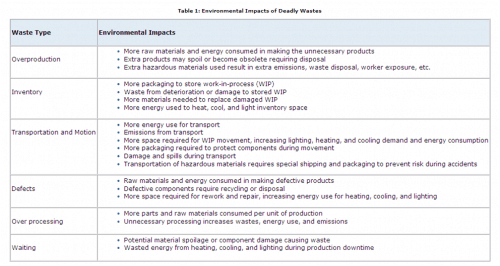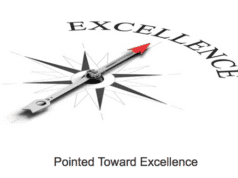 Mark's note: Today's guest blogger is Tim McMahon, who normally blogs at his called “A Lean Journey: The Quest for True North.” Tim has been a good friend of my blog and has been a frequently contributor to our little “Be More Careful” photo blog.
Mark's note: Today's guest blogger is Tim McMahon, who normally blogs at his called “A Lean Journey: The Quest for True North.” Tim has been a good friend of my blog and has been a frequently contributor to our little “Be More Careful” photo blog.
I'll be back from vacation soon and will resume new posts of my own July 1st or so. Now to Tim's post:
Green Is Lean
Many manufacturers know the benefits of Lean manufacturing: higher productivity, better quality, reduced cycle time, plus enhanced employee engagement. Lean is excellent at marshaling different groups and individuals into a high performing team focused on rooting out waste. That relentless focus on eradicating waste makes Lean a necessary partner for Green.
Environmental waste is any unnecessary use of resources or a substance released into the air, water, or land that could harm human health or the environment. Environmental wastes are often a sign of inefficient production, and they frequently indicate opportunities for saving cost and time.
Lean efforts can lead to significant environmental gains since environmental wastes are related to Ohno's 7 deadly wastes. The table below from EPA's Lean and the Environment Toolkit lists the environmental impact of these wastes. Click on the photo for a larger size.
Despite the relationships between Lean's 7 wastes and environmental wastes, many Lean implementation efforts often overlook opportunities to prevent or reduce environmental wastes. I have found adding the following 5 environmental wastes with the acronym WASTE to the traditional wastes helpful:
- Water: leaks, waste streams from processes
- Air: evaporation of chemicals, dust, particulate
- Solid Waste: filters, excess material scrap
- Toxic/Hazardous Waste: solvents, process residuals
- Energy: machinery on when not in use, heat loss, oversized motors
These five wastes raise awareness of the opportunities for improvements that not only affect the process, but also working conditions and overall environmental impact.
Environmental benefits from Lean alone are often incidental; they are not a result of an environmental focus or concern. Green and Lean should be synergistic not just additive or complementary concepts. The integrated whole of both methodologies is often greater than the sum of the impacts from each approach.
The tools in the toolkit for Green and Lean improvements are one in the same. They include techniques like value stream mapping, workplace organization and standardization with 6S, spaghetti chart, waste walk or treasure hunt, kaizen activities, and standardized checklists. As in Lean these tools are used to visualize and identify the wastes in our processes so we can eliminate or reduce them.
Photo from Fuss &O'Neill Single Point Lesson Archive
You can get started today with a number of simple efforts in conjunction with your improvement activities.
- Turn off equipment when not in use.
- Set computers to hibernate after 30 minutes of no use.
- Use light sensors or turn off lights when not in use.
- Rent or buy a thermal camera to find lose electrical connections in panels and transformers or overheating motors.
- Rent or buy an ultrasonic detector to find compressed air leaks.
- Work with your utility company to upgrade to energy efficient lighting.
- When purchasing new equipment buy Energy Star ® rated equipment.
- Establish a recycling program at your facility.
- Look at ways to reduce paper usage with smarter printing and paperless approaches.
- Reduce the amount of packaging you use to protect or contain your product.
The most obvious benefits of Green and Lean are cost savings which are synergistically coupled with value creation opportunities. Cost savings may include energy savings, productivity savings, and savings from improved utilization of materials. Value creation opportunities may include innovations that involve creation of new products out of waste materials and finding ways, in service delivery processes, to enhance customer's experience.
While the pursuit of Green and Lean is not a destination but a journey it is clear that organizations that stretch themselves to build a culture around the values of Sustainability, Excellence, and Equity will ultimately have a big advantage those who do not. Green and Lean is not a dichotomy rather it can be said being Green is Lean.
Tim McMahon is a lean practitioner with more than 10 years of Lean manufacturing experience. He currently leads continuous improvement efforts for a high tech manufacturer. Tim teaches problem solving skills, lean countermeasures, and how to see opportunities for improvement by actively learning, thinking and being engaged.
Tim McMahon has been supporting the AME Northeast Region Board of Directors as the Social Media Lead. His role is to identify how to best leverage social media tools for increasing networking within AME's Northeast Region.
Find Tim McMahon on the internet:
- Blog – A Lean Journey
- LinkedIn – TimothyFMcMahon
- Facebook – A Lean Journey Fan Page
- Twitter – TimALeanJourney
Despite the relationships between Lean's 7 wastes and environmental wastes, many Lean implementation efforts often overlook opportunities to prevent or reduce environmental wastes. I have found adding the following 5 environmental wastes with the acronym WASTE to the traditional wastes helpful:
Water: leaks, waste streams from processes
Air: evaporation of chemicals, dust, particulate
Solid Waste: filters, excess material scrap
Toxic/Hazardous Waste: solvents, process residuals
Energy: machinery on when not in use, heat loss, oversized motors
These five wastes raise awareness of the opportunities for improvements that not only affect the process, but also working conditions and overall environmental impact.
Environmental benefits from Lean alone are often incidental; they are not a result of an environmental focus or concern. Green and Lean should be synergistic not just additive or complementary concepts. The integrated whole of both methodologies is often greater than the sum of the impacts from each approach.
The tools in the toolkit for Green and Lean improvements are one in the same. They include techniques like value stream mapping, workplace organization and standardization with 6S, spaghetti chart, waste walk or treasure hunt, kaizen activities, and standardized checklists. As in Lean these tools are used to visualize and identify the wastes in our processes so we can eliminate or reduce them.
What do you think? Please scroll down (or click) to post a comment. Or please share the post with your thoughts on LinkedIn – and follow me or connect with me there.
Did you like this post? Make sure you don't miss a post or podcast — Subscribe to get notified about posts via email daily or weekly.
Check out my latest book, The Mistakes That Make Us: Cultivating a Culture of Learning and Innovation:












Hi Tim
Great summary of a very important topic.
Regards,
Tim, you are right on. Lean and green are synergistic. The company I work for has a group that is working on making the campus a Landfill Free campus. We already have one building that is landfill free. Everything is recycled. Certain materials go to a local company that uses the waste/trash as fuel. They have a method to burn it and create energy. In the next couple of weeks, I will be working with an engineer in the group to better educate how green and lean work together and are one in the same.
Great post.
Tim, you write Green is Lean, I would say the reverse is also true – Lean is Green. The more we can think of these as being mutually reinforcing, the more we can evaluate design as well as practices to see if they meet both parts of the partnership. Which makes me wonder what your thoughts are on the LEED program? It seems to be under a lot of debate recently and I wonder how it would enter into this conversation….